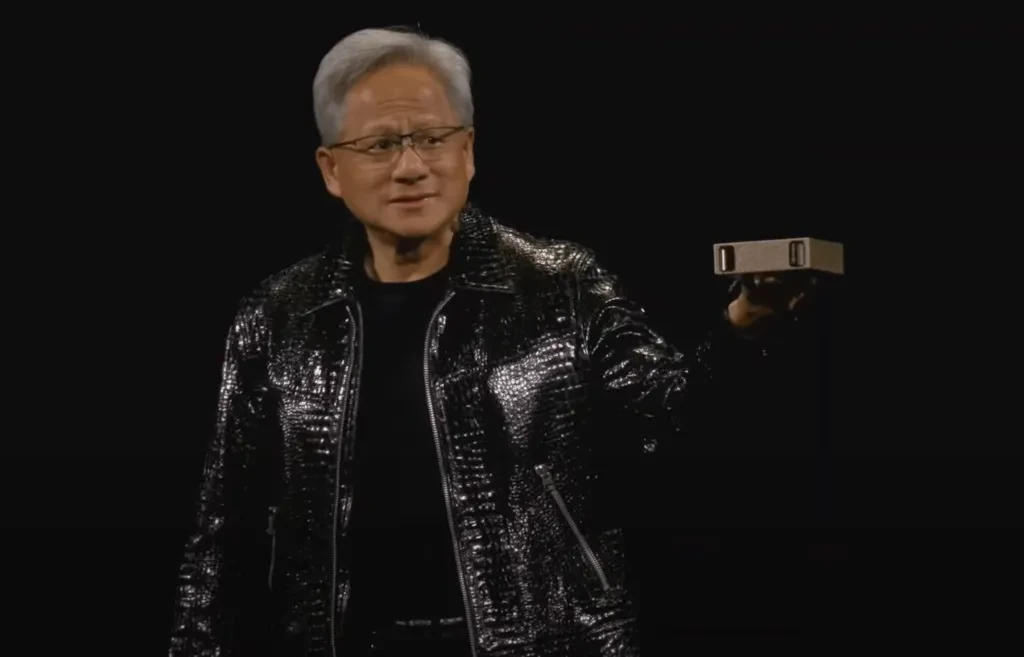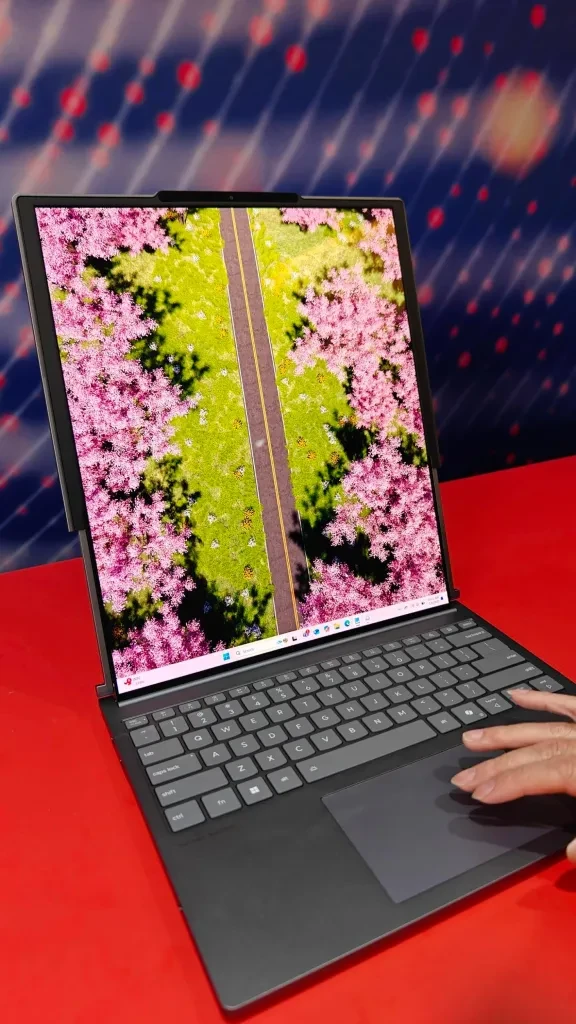In recent years, if you had to name the most “boring” product in consumer electronics, PCs would almost certainly take the title. As a category more mature than smartphones, despite increasingly powerful chips, PCs haven’t offered much surprise in terms of form and function.
However, on the first day of CES 2025, AI PCs became the most groundbreaking product. Jensen Huang, dressed in a new TOM FORD leather jacket, suddenly unveiled NVIDIA’s first AI supercomputer, Project DIGITS, equipped with the GB10 Grace Blackwell super chip.

On the same day, PC giant Lenovo also launched several new AI PC products at CES, exploring many different new forms.
The world’s first mass-produced rollable screen PC, ThinkBook Plus Gen 6, the gaming laptop Legion Pro 7i with NVIDIA RTX 5090 graphics card, and the first laptop with an under-display camera, YOGA Slim 9i, made Lenovo’s booth one of the hottest areas at CES.

Will AI trigger another boom in this lukewarm PC market? Why are AI PC sales still not meeting expectations? Even Jensen Huang couldn’t escape the media’s probing questions after his globally shocking presentation.
Jensen Huang believes the issue lies in the concentration of AI ecosystem resources in the cloud, leading to insufficient development on the device side. Besides NVIDIA, the largest AI arms dealer, Lenovo, the world’s largest PC manufacturer, also has significant insights on this matter.
During CES, Lenovo Group’s Executive Vice President and President of the Intelligent Devices Group, Luca Rossi, was interviewed by iFanr and other media outlets, addressing questions about AI PC form innovation and development expectations.

Like Jensen Huang, Luca Rossi firmly believes that AI PCs are not a false demand and remains optimistic about the market in the coming years. Facing competitors like NVIDIA entering the field, Luca is also confident:
“Currently, one in every three activated Windows computers worldwide is a Lenovo computer. Among our competitors, who has such a broad product line as Lenovo?”
Below is the conversation between iFanr and other media with Luca Rossi, edited:
AI PCs Are Not a False Demand
Q: NVIDIA’s CEO Jensen Huang stated that the development trend of AI PCs is flat because more users are opting for cloud-based products rather than upgrading to AI PCs. Do you agree with his view?
Luca: I think the data shows that the PC market in 2024 was indeed relatively stable. The final market data is not fully compiled, but it’s roughly around plus or minus 1%, basically flat. So, from this point of view, you can agree with Jensen Huang’s statement that the market in 2024 indeed did not grow. But I’m not too worried about this because the technology was ready in 2024, and there are many reasons to believe that the market will grow in 2025 and 2026. I can give a few examples:
The lifecycle of Windows 11 or Windows 10 will end in October 2025, which will inevitably lead to a large demand for device replacement.
There are 400 million devices purchased during the pandemic, which have now been used for 4 to 5 years and are also at a replacement point.
At the same time, the interest or catalytic effect of AI PCs will also drive users to choose AI PCs. Even if users currently feel they don’t fully know the reason to buy an AI PC, perhaps because related applications are not fully ready, they will still have a future-oriented purchasing motivation.
This means that when users replace their computers, considering the future, they will find it hard not to choose an AI PC and instead buy an old PC, knowing that the old PC might need to be replaced again in a year.
Therefore, I think the question is not “if” AI PCs will develop, but “when” they will become widespread. I am confident in the AI PC market performance in 2025 and 2026, and we will see significant growth in the AI PC market by then.
As for the cloud versus local issue you mentioned, I think the fundamental core is Hybrid Cloud. Some tasks need to be processed in the cloud, while others need to be completed on edge devices. For example:
When processing low-latency needs on edge devices or dealing with highly private content, users may not want to upload this content to any cloud but prefer to complete it locally.
On the other hand, if you need to process a large number of images that have no privacy issues but require strong computing power, then the cloud is obviously a more suitable choice.
Therefore, we believe the future of AI PCs is not solely cloud or edge processing, but hybrid cloud. This is the key direction we are pushing for and what we consider our core advantage.
Q: Many people now say that AI PCs or AI phones don’t really have a demand or market. How do you view this issue?
Luca: No, I don’t think it’s a false demand. Think about it, it’s actually quite simple. AI PCs and AI phones can give humans “superpowers,” right? They can allow you to complete tasks in 2 minutes that might have taken 25 minutes or even 2 hours before. So, I can’t imagine this being a “false demand.” When you press a button and the machine can complete a PPT for you in 2 seconds, whereas before you needed 2 hours, I think that’s a kind of human “superpower.”
The Future Form of AI Hardware
Q: We saw Lenovo release many different types of products at CES, such as Yoga, ThinkBook, and the new ThinkPad. Which one is your favorite?
Luca: Oh, my favorite product? I would answer with two products. I really like our brand new ThinkPad X9. I think its launch timing is perfect, especially when facing competitors. You know we have the X1 Carbon, right? You might have heard of the X1 Carbon.
The X1 Carbon is our enterprise flagship laptop. The X9 is also a flagship, but it targets high-end consumers. I think it’s an outstanding device. Additionally, as you know, we collaborated with Intel on a major project called Aura Edition, bringing a new experience to this device. So, it’s no longer just about how much storage it has, but about how it delivers a new user experience. I am very optimistic about this product, and I really like it. I would switch to this laptop.
The second device I like, for different reasons, is our Yoga, which features an under-display camera. This product is fantastic. If you haven’t seen it, you must check it out. It weighs 1.1 kilograms, is very thin and light, and has the highest screen-to-body ratio of any device in the world. I think it’s very beautiful.
Q: There was a lot of AI hardware at CES. What kind of new devices or new forms do you think might emerge based on AI in the future?
Luca: “Every device will eventually have AI capabilities,” it’s just a matter of time to see which device will achieve it first. I think this includes two elements. One is AI, and the other is natural language interaction triggered by AI. Because now you can talk to devices, which opens up possibilities for new form factors. For example, if you can talk to a device, you don’t need a keyboard. So, I think you will see every device upgraded to AI devices, and there will also be some entirely new form factors based on natural language interaction.
Devices will also become smarter, like understanding more about the environment through sensors. For example, devices need to know the room temperature or determine if the user is moving left or right, which requires various sensors like gravity sensors.
So, these sensors will be integrated into many devices. I think it will be a very exciting world. At Lenovo, we are also preparing for this. Therefore, we aim to lead in AI PCs, AI tablets, AI phones, and are also working with Motorola to develop new IoT (Internet of Things) devices to achieve a complete ecosystem.
We believe the ecosystem is very important. Because when you have an AI experience, you want the AI engine to know everything about you. Of course, privacy is very important. But when you switch from a PC to a tablet, phone, watch, or even a smart ring, you want the AI knowledge base to be connected, not fragmented. That’s why we have invested heavily in Smart Connect. It is our ecosystem software that can connect your PC, phone, tablet, and all devices.
In China, we have “Xiaotian” as an AI assistant. Our goal is, “whether it’s from a phone, PC, or glasses, the AI assistant can know everything about you. This is a very exciting field.”
Q: What is your vision for AI PCs or AI hardware devices in five years?
Luca: Honestly, five years ago, I couldn’t predict that ChatGPT would appear within five years. So, when you ask me to predict five years into the future, it’s really hard to know exactly what will happen because many new things are constantly emerging.
But I can tell you one thing. I believe that over time, some entirely new device forms will emerge. These forms may not completely replace traditional devices but could become important new forms. For example, the main limitation of mobile PCs now is that you need a keyboard. If the keyboard disappears, the form of such devices can completely change.
Another thing that interests me greatly is the potential of glasses. I think, in the long run, glasses will have great potential. Of course, there are still many technical barriers, such as battery life and heat dissipation. But as technology advances, I believe glasses will become very important in 5 to 10 years.
Q: At CES 2025, we saw AI glasses everywhere, especially as a computing device. I’m curious and very interested in the productivity of AI or XR glasses. What are your thoughts on this?
Luca: I believe glasses will become a very important platform in the future. But I don’t think this future will appear in 2025. The reason I think so is that there are many obstacles, such as battery, thermal management, performance, and the form factor design of the device. These are all issues that need to be solved.
Additionally, we should learn from some past experiences. For example, you might remember that many years ago, 3D TVs were considered a global trend, and everyone thought that in the future, everyone would buy TVs with 3D glasses. But it turned out to be one of the biggest failures in the industry at that time. The reason was that people were unwilling to wear bulky and uncomfortable devices.

If you want glasses to be very thin, light, and comfortable for people to wear, the required technology is far beyond our current level. However, this does not mean it cannot be achieved in the future. I believe it will succeed.
Therefore, I think in 2025, we will see some progress, but the market will still be small, just starting. Some application scenarios may be more mature, while others will be less mature. For example, a more mature application scenario might be productivity scenarios when performing specific tasks in factories or assembly lines. Because in these scenarios, wearing glasses is not for entertainment but to complete work tasks. You might only need to wear them for an hour, but they can significantly enhance your work value. So, such scenarios are possible.
Another scenario is for what we can call “geek” users. This group of users won’t reach millions, maybe only hundreds of thousands, but they are very passionate about this technology and are willing to use it even if the device is not particularly comfortable.
But if you ask me whether AI glasses can compete with smartphones and become a major platform for hundreds of millions of users? My answer is yes, but not in 2025 or 2026. That is a more long-term vision that requires technology to truly mature. However, I am very confident in the future of glasses, and I really like this direction. Obviously, when the technology matures, we also hope to be part of this field.
Q: What are your thoughts on AI-related hardware? What will be the trend of future products?
Luca: This topic is almost endless because I believe AI will gradually penetrate most, if not almost all, accessories and products sold in our industry.
For example, AI can also add value to docking stations. For instance, a docking station can sense whether it needs to turn off or on the power or provide many other functions. Therefore, this is clearly a huge opportunity because it will drive the replacement of almost all accessories. It’s just a matter of time and finding the key to creating value for users.
“We won’t add AI features just to put the word ‘AI’ on the product packaging. You need to find places that truly create value for users.”
This value creation can be direct, such as providing more skills and capabilities to users through computers; it can also be energy-saving opportunities, contributing to ESG (Environmental, Social, and Governance) goals; or it can be other aspects of value. But I believe AI features will eventually be everywhere.
Lenovo Xiaotian, aiming to be the preferred gateway for users to interact with the world
Q: What are Lenovo’s plans for personal intelligent assistants in the AI era? What are the next steps for “Xiaotian” and “AI Now”?
Luca: This is clearly a new area of development for Lenovo, and frankly, a new area for the entire industry. When I look at the competitors in the industry, I believe we are at the forefront. We are already ahead in certain areas, such as in China, where this technology is already shipping; in Europe, it is about to launch; and in other parts of the world, it will start shipping next month. We already have an agent with hybrid orchestration capabilities, partly in the cloud and partly on the device.
This means that users’ personal knowledge bases are stored locally on the device, which is very important. Most competitors, possibly all, only have the cloud part. So I think we are in a good position, but to be honest, we are still at the beginning of this long journey.
In the next two years, you will see us upgrading AI Now or “Xiao Tian” every quarter. This is because it is now a software experience, and users expect frequent updates to improve their experience.

The good news is that we have received a lot of feedback. We learn from data (of course, respecting privacy) about users’ behaviors, what they like or dislike. This will help us with updates.
Our goal is to make “Xiao Tian,” especially the “Xiao Tian” ecosystem in China, the preferred gateway for users to interact with the world. This means users can interact with the internet, ask questions, and do all these things through “Xiao Tian.” We hope these features can all be realized through “Xiao Tian.” Of course, you will also see that we are preparing many innovations. This is a brand-new field.
If you look back at the PC industry, as a company that has been leading in the PC field for many years, we have deep expertise in hardware, but relatively less experience in software. However, we are rapidly building this capability. We are hiring software engineers, AI engineers, and many talented individuals who can bring us research and development capabilities and intellectual property.
Promoting AI PC Adoption, Not Through Price Wars
Q: At CES 2025, NVIDIA also announced they would develop AI PCs. How does Lenovo view the future competition and opportunities for AI PCs?
Luca: We are still continuously pushing for market share growth. We measure market share from multiple dimensions, but I can tell you that now, one in every three activated Windows computers globally is a Lenovo computer. From the activation volume, our market share growth trend is very good.
From the global shipment perspective, we are not only the industry leader, but in the five major regions we operate, we are number one in four of them, except for the United States. At the same time, we are also number one in both the consumer and commercial markets. The gap between Lenovo and the second-ranked manufacturer is still widening, so we are very satisfied with our progress in this regard.
Looking ahead, our goal is to continue expanding our global leadership and lead the transformation of AI PCs. We expect the penetration rate of AI PCs to reach 40%-50%, or even as high as 80%, in the next two to three years. It is foreseeable that in the next three to four years, every PC will become an AI PC. If we want to secure the future, we must be more proactive in the AI PC field.
How do we achieve this goal? Obviously not through price wars, but through innovation.
We want to provide the best quality, security, speed, design, and aesthetics to the market and users. At the same time, we believe the industry is changing. Compared to five years ago, today’s technology choices are more diverse: from having only one or one and a half chip suppliers to now having three to four choices; from the X86 architecture to the ARM architecture; and the addition of AI Agents, which will be a brand-new battlefield. We believe differentiation can be achieved in this new world. Users can choose different chips, AI Agents, and even more innovation in device form factors.
Through innovation and differentiation, we hope to grow faster than our competitors globally. We will develop in a balanced way in each region, with a particular focus on the high-end market. In addition, our business model is also unique. We adopt a “global-local” approach, managing business globally while operating in 180 countries and empowering local management teams with decision-making power. I think this model is hard to find among our competitors.
Last but not least, which of our competitors has as broad a product line as Lenovo? From Windows to Chrome, to Android, from 6-inch screens to 30-inch all-in-one devices; from portable devices to enterprise-level cloud infrastructure solutions.
Therefore, I believe we are very well prepared for the AI revolution.
Q: You mentioned that “killer apps” might appear in the next two years. In which areas do you think these killer apps might emerge in the next two years?
Luca: In 2024, I think we can say we are ready to bring the foundational technology of AI PCs to market.
Now, I think 2025 to 2026 is the time for the industry to deliver new user experiences based on these foundational technologies. When I mention foundational technology, an important element is undoubtedly the new neural processing units (NPUs) in chips, which are key to driving AI PCs; you can think of Qualcomm chips, Intel’s Lunar Lake, AMD’s Strix, and AMD will also launch Kraken. So, there is a lot of innovation now.
Of course, realizing the user experience requires hardware, and software becomes very critical to continuously drive the user experience. You could say Copilot is one of the first software or elements of the new user experience. I think in 2025, we will see Microsoft bring many innovations in this field that were previously impossible.
Speaking of AI, I believe this is indeed a revolution because it will not only help users in a specific field but will be integrated into many experiences.
When you ask me which areas will be affected, if we look at the short term, I think productivity, personal productivity, and enterprise productivity might be the easiest areas to achieve. But from a consumer perspective, gaming is also an area where AI will deeply penetrate and bring many new usage patterns.
Imagine, there are currently about 150 software developers or independent software vendors (ISVs) writing code and upgrading their software to take advantage of NPUs. What will this bring?
Many functions or codes currently running on CPUs will shift to running on NPUs, which not only reduces the CPU load but also lowers power consumption. These workloads can run continuously, enabling many new experiences. Therefore, I would say all applications and usage scenarios of PCs will be activated and improved. Productivity might be the first area to be affected.
Additionally, I want to add some more futuristic content: the availability of NPUs also makes “Large Action Models” possible, which go beyond today’s “Large Language Models,” no longer just talking to machines, but systems will start taking actions for you. Systems can communicate with various applications and achieve goals for you, which may still sound like science fiction today.
For example, now if you want to call a taxi, you might use an app like Didi. But in the future, you just need to tell your phone or PC “I want to go there,” and the PC will directly interact with the app.
So, we are moving from an app-based world to a world based on your ideas, where machines can understand you and know the context of what you are doing. Machines know everything you know, and even more, and can take action for you.
Of course, this will take some time and will not be achieved tomorrow. Its realization requires the collaboration of multiple partners and various elements working together.
Source from ifanr
Disclaimer: The information set forth above is provided by ifanr.com, independently of Alibaba.com. Alibaba.com makes no representation and warranties as to the quality and reliability of the seller and products. Alibaba.com expressly disclaims any liability for breaches pertaining to the copyright of content.



